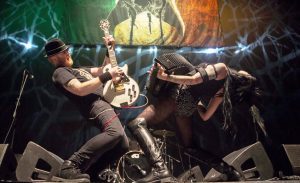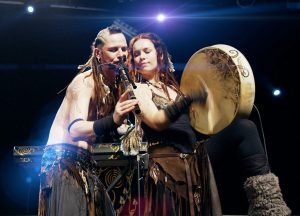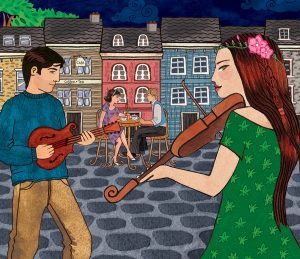
How great is it when you are cycling through radio stations, maybe on a quiet drive through the countryside of wherever you happen to be, and the folk masterpiece We Rise Again – performed by Cape Breton supergroup The Rankins – roars out over the airwaves? It makes you feel almost immortal in a sense, connecting you with generations of people who came before.
One of the great Celtic power ballads known the world over, the band’s version of We Rise Again introduced Celtic music to whole new audiences.
But just how Celtic is it?
That’s not to cast any doubts on the Rankin family, or the authenticity of their work – obviously, their music can be considered Celtic by today’s standards. But ask a Scot alive during the Highland clearances? You might have gotten a different answer.
“It is going to be different from what you’d hear in Scotland today, or what you would have heard in Scotland 200 years ago,” says Heather Rankin, who first performed the song with her family 1993. “It has evolved over the last couple hundred years here. Now, it is all relative to where you are, and who you are talking about.”
This brings us to the question; what is Celtic music? Is it the same everywhere? What has it been, and what has it become?

Today, it is almost impossible to define Celtic music as one single thing. Instead, Celtic Life International broached the topic to a number of performers, musicians and music experts to get their perspectives on an ever-evolving genre.
“I can understand why people would have difficulty describing it,” says Ellen MacIsaac, a Celtic music professor at both Ottawa University and Carleton University in Ontario.
One of the first things MacIsaac asks of her students at start of each school year is to try and define Celtic. The answer is never obvious.
“One of my favourite tricks is to play them pieces from Wales and Brittany, and then ask them if they think it sounds Celtic? Often, the answer is no. Without seeing the visual context of anything Celtic, people don’t necessarily know that they are listening to a Celtic piece of music.”
MacIsaac adds that it can be difficult to even identify what sounds, melodies, and themes make up the DNA of Celtic music, as the Diaspora has produced so many disparate styles over the centuries. Often, it comes down to context.
“We are accustomed to hearing certain kinds of music and calling that Celtic. What makes something Celtic? Well, part of it is the expectations of the people that are listening.”
“In North America, we have our own particular take on things because we look back on our ancestry with very rose-tinted glasses – a very romantic notion of Celtic identity – that doesn’t necessarily have much to do with life on the ground in a Celtic country.”
In North America, the sounds of fiddles, pipes and drums belting out classic folk tunes at pubs and festivals is considered traditional “Celtic.” In an actual Celtic nation like Ireland, that stuff is outdated, equivalent to The Charleston or The Jitterbug.
“For them, the traditional stuff is old hat,” says MacIsaac. “I met a lot of people in Ireland who would swear up, down, and sideways that Celtic Woman doesn’t qualify as ‘Celtic.’”
So does that mean “traditional” Celtic music isn’t traditional? No – it just means that it is not traditional to everyone.
“It depends where you are from,” says Dawn Beaton, the artistic director of the Celtic Colours International Festival in Cape Breton, Nova Scotia. Beaton and her sister Margie grew up playing traditional Gaelic tunes on the fiddle, but Beaton recognizes that what she calls traditional is fairly new in the grand scheme of Celtic music.
“We pull some of our repertoire from the more immediate past,” she explains, “Cape Breton composed tunes from the last 80 years or so.”
Those eight decades of music are informed by the culture that came before it, of course, but older tunes were largely – almost exclusively, even – passed down by oral tradition. From one generation to another, small changes were inevitable. With time, and with vast migration patterns, those changes snowballed.

“For some of the really old, old tunes, who really knows where they have come from?” muses Beaton. “We might sometimes think we’re playing a Scottish tune, when really it is Irish in origin. So much of that music went back and forth between those two countries before coming over here.”
It’s hard to keep it all straight – even in the same region. Cape Breton’s Celtic Colours International Festival showcases talent from across Atlantic Canada each autumn, and Beaton says that a sensitive ear can distinguish differences in style and form, even from community-to-community.
“To the untrained ear, it probably sounds quite similar. But there is a very interesting difference between Newfoundland, Prince Edward Island, and most of Nova Scotia – even within Nova Scotia, and even within Cape Breton!”
Centuries of evolution isn’t the only factor affecting Celtic music, however; today’s players want to put their own stamp on the sound.
“The sheet music that you get in a music book is just a skeleton, really,” continues Beaton. “You might start with that, but eventually you will put your own inflection on it.”
“How could there not be change over time? There is naturally going to be different influences on Celtic music and how it is performed.”
That said, Beaton notes that much of the music still being played on Cape Breton Island is largely the same as when the Scottish Gaels first settled the region hundreds of years ago, and that she and many others strive to keep it that way.
“We come from very humble roots, and it’s not only ours to take off in another direction.”
There are others, however, who aim to push the genre to new places.
“Call it Celtic fusion, cross-Celtic, or perhaps pan-Celtic,” says Celtic Life International’s Managing Editor Stephen Patrick Clare, a long time musician, music critic and historian.
“Like most other sonic styles, Celtic music has pollinated across musical and geographic boundaries, with all sorts of great new sub-genres popping up, including Celtic Death Metal, Celt-Rock, Celtic Jazz, Celtic Rap, and more. It’s quite exciting to witness the evolution.”
Clare counts Calan, Eluveitie, Afro Celt Sound System, Shreem, Mägo de Oz, and the Waterboys among his favourite contemporary Celtic artists, but notes a special affinity for Celt-Punk.
“The Pogues, the Dropkick Murphys, the Mahones – there is something about the melange of traditional melodies and hardcore aggression that gets the blood going.”
He’s not alone in that regard.
“We are a punk band with Celtic overtones,” says Tobin Bawinkel of Chicago’s Flatfoot 56.

“My parents were heavily into bluegrass and folk music, and we played all the time as a family. I picked up the guitar when I was 12, and I fell in love with punk soon after. Flatfoot 56 started as a hardcore band, but came under the Celtic influence after we discovered the Clancy Brothers, the Chieftains and the Pogues.”
Finny McConnell can relate.
‘For me it was the raw energy of the Pogues, the Clash, and the Who,” shares the frontman for Kingston, Ontario rockers the Mahones.
“Growing up in Ireland, there was music of all sorts was going on in the clubs and on the streets. We had Rory Gallagher, the Clancys, Thin Lizzy, U2, Stiff Little Fingers, the Dubliners…it was this huge smorgasbord of styles and sounds.”
Heather Rankin experienced Celtic fusion first-hand at a Kansas City Showcase.
“It was like a metal punk band that did bluegrass, but they were definitely Celtic,” she recalls. “I couldn’t put my finger exactly on what it was that they were going for, but I could certainly hear the Celtic thing in it.”
Rankin is no stranger to pushing the Celtic envelope; her group often put a contemporary spin on classic Celtic tunes.
“We harmonized a lot, and often used electric and non-traditional instruments. I believe it is what made us interesting. Otherwise, it would just be the same songs, played the same ways, and nobody would care. Because we allowed other influences to find their way into what we were presenting, we were able to bring a bigger audience to Celtic music.”
“You can’t put music in a museum.”
Of course, Celtic fusion has its critics. It’s not hard to see how some purists might scoff at something like Celtic Punk, and decry it as illegitimate. But then again, that kind of attitude is hardly new.
“There will always be the perception from the older generation that the younger generation is taking it and changing it,” says Beaton. “I think that’s been the complaint for every generation for the last 200 years…there’s naturally going to be different influences on the music and how it’s performed.”
But is Celtic fusion music truly Celtic music? Or is the Celtic element a mere affectation – a flavour to spice up the melody? Again, it comes down to context, and what listeners bring to the table.
“By all means, it’s Celtic,” insists Rankin. “If it makes you think that, then it’s got to have some Celtic elements.”
Although Celtic fusion might be experimental, that doesn’t mean it dishonours Celtic customs; a Celtic Death Metal band might be more in tune with Celtic heritage than purists.
Ellen MacIsaac believes that young artists across the seven Celtic nations are looking for new and relevant ways to express their cultural pride and identity.
“By way of example, look at Wales where there has been a big push over the last 25 years to resuscitate their language. Incorporating it into contemporary music is one way of doing that.”
 MacIsaac explains that traditional folk music in Wales dissipated when the Methodist Church discouraged the use of the Welsh language. As a result, most of the country’s residents now consider religious hymns as folk music.
MacIsaac explains that traditional folk music in Wales dissipated when the Methodist Church discouraged the use of the Welsh language. As a result, most of the country’s residents now consider religious hymns as folk music.
“Today, however, you find pop artists and folkie singer-songwriter-types in Wales writing in Welsh, but taking it in a completely different direction to save the language.”
She also points to the new wave of Irish heavy metal bands that incorporate elements of Eire’s legend and lore into their throaty refrains.
“These bands reference all sorts of mythological events. For example, they might write about the legend of The Táin – the famous Cattle Raid of Cooley – one of the great epics of Irish tradition. In that regard, they are delving deeper in history than most folk musicians. It’s a great way to preserve and promote that heritage to younger audiences.”
So, to recap; if wild offshoots of traditional Celtic music can be considered truly “Celtic,” but traditional Celtic music might not be as traditional as we think, then what exactly is Celtic music today?
The best answer is probably “all of the above.”
Given how far back the history of the Celts goes, and how wide-spread their descendents are today, it is almost impossible to pigeonhole the genre to fit any one concise description.
“That’s like trying to figure out how to undo a knot,” says MacIsaac. “Where do you even begin?”
Celtic music is almost like an organism. It is a living thing, and all the individual parts need each other to keep the whole creature alive.
“I think we are able to attract a wider audience to Celtic music when we allow other influences to weave their way into what we are presenting,” says Rankin. “Celtic music has to evolve to expand its audience, and reach younger people so that it doesn’t die out with the older generation.”
Celtic fusion, she continues, draws in new listeners who might not have otherwise been interested in the genre. That initial point of contact could help them better appreciate the core traditional Celtic experience.
“Of course, you’re going to have pockets of purists, and you’re going to have places where the music stays the same for a number of generations.”
“There is something for everybody,” adds MacIsaac. “The tradition-bearers are there at the core, while the experimental stuff is there to draw people in. Gatherings like Celtic Colours International Festival are ideal for showcasing those things.”
“There is a place for both,” agrees Beaton, “so long as there is both.”
 Perhaps the most exciting development in Celtic music these days is seeing its popularity grow on the global stage.
Perhaps the most exciting development in Celtic music these days is seeing its popularity grow on the global stage.
“It is really starting to branch out,” says MacIsaac, adding that Celtic music enthusiasts are popping up in places you might not expect, including Tokyo, where Comhaltas – the Irish Music Association – has been talking about opening a chapter.
“We have a long history of Celtic music being the fundamental expression of the Celtic peoples, whether they come from the Celtic nations, or from any of the Diaspora groups around the world. And for a long time, we owned it. It was our way of expressing ourselves.
“Today, people who aren’t necessarily Celtic in background are getting into it. It’s moving away from being an isolated cultural expression to becoming something else, though I’m not sure there is a name for it just yet. I’m very interested to see what ends up happening.”
-Story by Chris Muise




















Leave a Comment